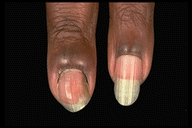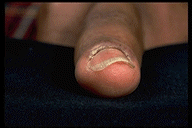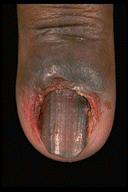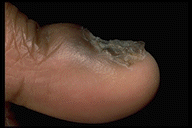 |
The cuticle is missing. The posterior nail fold is swollen and the nail is ridged. The cuticle is softened and destroyed by frequent immersion of the hands in water. Candida albicans is an opportunist which invades the nail folds causing inflammation and oedema. This disturbs nail growth resulting in ridging. |
 |
The posterior nail fold on the left is clearly swollen in comparison with that on the right. The cuticle is missing and it is through this space that the organism gains entry. The side of the nail plate is discoloured greeny yellow where it has been invaded by Candida. |
 |
The cuticle acts as a seal. The absent cuticle and the space between the skin and the nail which is opened up permits the entry of the opportunistic fungus, Candida albicans. The condition occurs in those who get their hands frequently wet such as housewives, domestics, chefs and nurses.
|
 |
There is a considerable swelling of the nail folds. The cuticle is missing and the nail is discoloured brown, secondary to invasion by candida. Treatment with an oral anticandida agent is required. |
 |
The nail plate when invaded by candida is usually discoloured brown. This is a late development. The bolstered swollen posterior nail fold, so characteristic of a chronic paronychia, is clearly demonstrated. |




